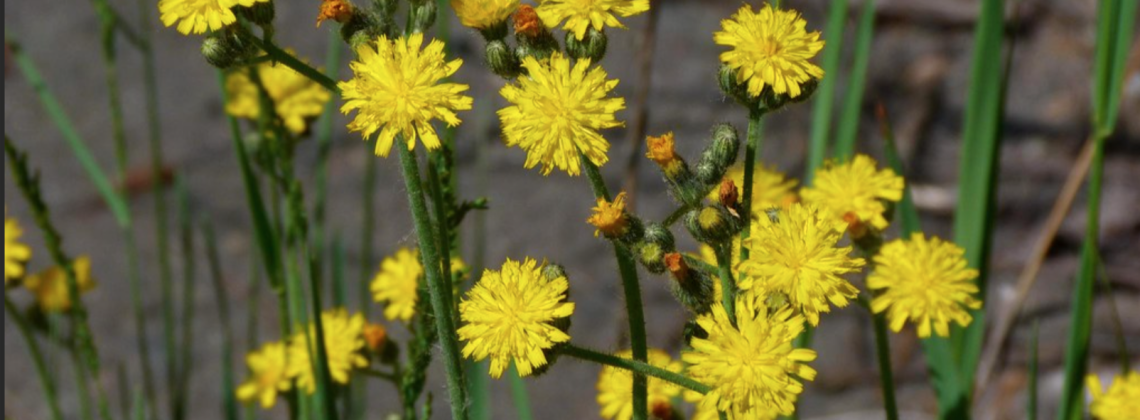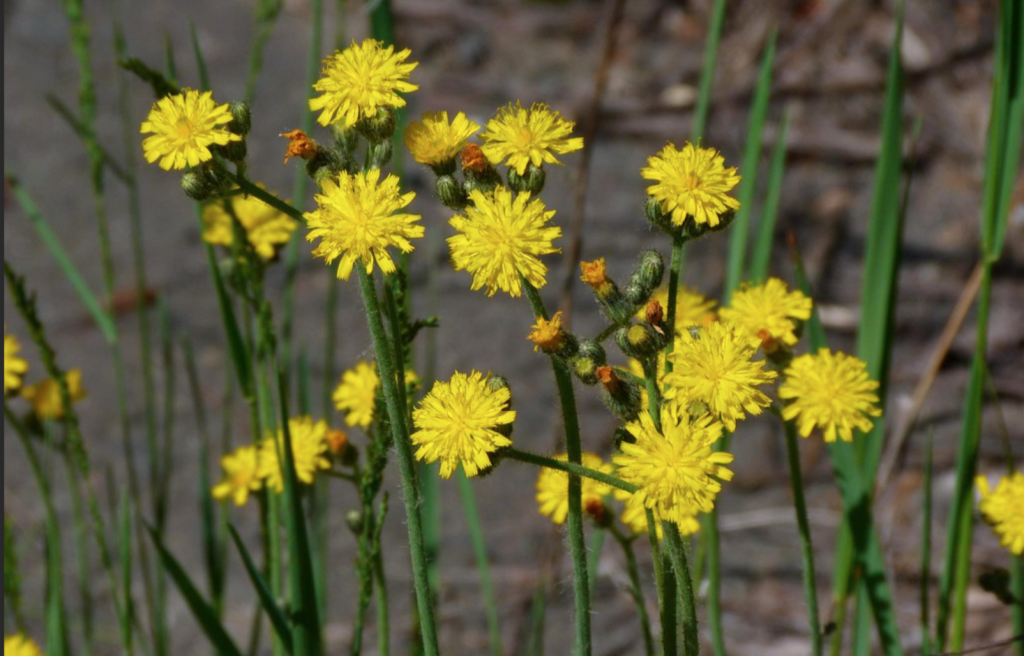

Hail to the weed that rides the coattails of human ambition (and of Star Wars, too)
I met a new flower a few weeks ago. I was traveling in Virginia with my family and, as it turns out, with some extremely ambitious microorganisms. We had planned to do some hiking along Skyline Drive in Shenandoah National Park but instead found ourselves recovering from viral gastroenteritis. Fortunately, there was a screech owl and three owlets in the maple tree just outside the front door of the house we rented. Our adventures for the first day or so amounted to sitting on the front porch observing softball-sized owlets as they fluffed their downy feathers and blinked drowsily. That and very slow walks down the dead-end street—which is where I encountered what looked like an enormous dandelion or hawkweed: two feet tall, with yellow composite flowers and the telltale globe-shaped seedheads known as “blowballs,” except that these were almost as big as the owlets. My toddler blew the seeds and got a face full of fluffy achenes. They floated away, but sort of heavily. You could almost hear them clattering and scraping across the asphalt.
The plant was not hawkweed or dandelion but meadow salsify (Tragopogon pratensis), also known as Goatsbeard or Jack-go-to-bed-at-noon, from its habit of closing its flowers at midday. But I wasn’t too far off: It’s in the same tribe as dandelion (Taraxacum) and hawkweed (Hieracium), all members of the very large Aster family, some 30,000 species strong. There are yellow hawkweeds and orange hawkweeds and white hawkweeds, mouse ear hawkweeds and panicled hawkweeds, Canadian hawkweeds and southern hawkweeds. Hairy, smooth, spotted, prickly, and rough hawkweeds. Whiplash, slender, and tall hawkweeds. Narrowleaf and houndstongue and roughstem and—my personal favorite—veiny hawkweed, a common Eastern woodland species that lifts delicate yellow flowers on spindly stems above leaves dramatically veined in deep purple. “These little hawkweeds,” Henry David Thoreau commented in his journal, “are to me a rather interesting family, so unpretending.”
According to John Parkinson’s seventeenth-century herbal, hawkweeds have been used as a cooling, drying, and binding medicine, good for “the heate of the stomacke, and for inflammations, and the hot fits of agues and gnawings of the stomacke,” as well as for hemming in sexual desire and “venereal dreams.” Hawkweeds have also been troublesome pasture invaders, forming dense mats of roots and rosettes unpalatable to cattle and sheep. “Instances are by no means rare,” a Southern Planter correspondent reported in 1916, “when whole mountain sides that were once fine grazing land are now nothing but a barren mass of hawk-weed.”
Hawkweeds are one of several plant genera that reproduce primarily through the asexual production of seeds, a strange and still-mysterious process known as apomixis. Seedlings are thus frequently genetic clones of their parents, which means that clonal populations are often misidentified as new subspecies. “To set forth the whole family of the Hawkeweedes in due forme and order, is such a world of worke,” wrote Parkinson, royal botanist to Charles I of England, in The Theater of Plants (1640), and then preemptively apologized. “If I therefore . . . slippe or goe awry, let it be pardoned in me . . . . For such a multitude of varieties in forme pertaining to one herbe is not to be found againe.”
Hawkweeds are everywhere right now in the southern piedmont, cheery golden flowers raised on branching stems a foot or more above rosettes of leaves. Even if they are clones, a field of them on the wayside is a romantic sight. A place you would take your child for a morning stroll, or your beloved for a picnic.
It reminds me of something. Clones, picnics, sexual desire . . .
Ah yes, that’s it. Anakin Skywalker and Princess Padmé romancing in the meadow on the planet Naboo. While the young lovers debate politics and Anakin betrays his fascist sympathies, the hawkweed and daisies and buttercups wave in the breeze and, somewhat unconvincingly, bend under the feet of the hippo-like creatures called Shaaks. This was a formative scene for me. It’s where I learned that stilted, unbelievable dialogue was not just a feature of low budget Christian TV. It has also yielded one of the more useful memes of the twenty-first century:
The four panel “clueless Padme” has many applications. For example:
I’ve been writing about weeds for the last few years, which means I’ve had to think a lot about significance—in those Padme-blank-stare moments after I explain the project. This is not something you have to deal with when discussing Star Wars. Its multimedia incarnations have earned more than $50 billion. Even its parasitic media, like memes, can seem tremendously powerful. “For the Better, Right?” got 16,000 retweets in the first month and its various iterations have generated approximately 500 million utils of cynical delight, if my back-of-the-envelope calculations are correct. As a water-cooler conversation starter, Star Wars is almost as reliable as the weather, especially since there’s a new spin-off approximately every week. The franchise made George Lucas a billionaire, and now he is fixing education and stuff.
But from another angle, the influence of Star Wars pales in comparison to the hawkweeds and dandelions and goatsbeards of the world. The soil they’ve held in place, the insects and ungulates they’ve fed, the grasses they’ve outcompeted, the hope (if not healing) they’ve given to sufferers of ailments, the joy they’ve given to youthful seed blowers and flower gatherers—they’ve done all of this for many millennia. Their influence is incalculable. Will anyone remember The Clone Wars in a thousand years? But hawkweeds, cloning their way across the disturbed landscapes of the world, will almost certainly still be here.
Which conjures a slightly different meme:
It’s not that hawkweeds are indifferent to human ambition. They ride the coattails of human ambition each time we widen a road or construct a shopping center. On a grander scale, hawkweeds have spread everywhere Europeans have colonized. They are what the historian Alfred Crosby famously called “portmanteau biota”—suitcase species—that thrive in “ephemeralized environments.” They are the undesignated beneficiaries of human disturbance and movement.
But hawkweed also doesn’t depend on us. Its plumed seeds ride the wind, which blows where it will. Like any number of colonizing plants, they will take up residence in any area disturbed by fire or storm or animals. And because of that independence, that life apart from our own, that green and gold vigor that we can do almost nothing about, hawkweeds may have the capacity not just to benefit from foolhardy human ambition but also to absorb human pain—not by reducing it but, as the Czech philosopher Erazim Kohák suggested, by absorbing it. The ubiquitous hawkweeds might point us toward “the wisdom of bearing the pain that can neither be avoided nor abolished but can be shared when there is a whole living creation to absorb it.”
Is that too much to ask from a lowly weed? Maybe. But then I thought asexual seeds were also too much to ask.
William Thomas Okie is the author of The Georgia Peach: Culture, Agriculture, and Environment in the American South and “Amber Waves of Broomsedge.” He teaches history at Kennesaw State University in Georgia.